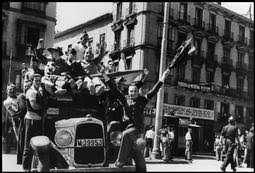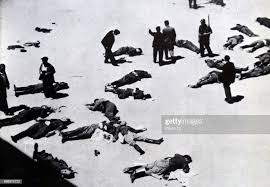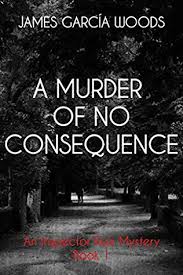A Murder of No Consequence (1999) by James Garcia Woods
GoodReads meta-data is 278 pages rated 4.03 by 91 litizens.
Genre: krimi

Verdict: D&D (Deep and Dark)
It is early July 1936 in Madrid and the stifling summer suffocates everything in Madrid. Early one morning Inspector Ruiz and Sergeant Felipé are called to investigate the corpse of a young woman found in a vast Retiro public park. These are homicide dicks and this is a homicide. The questions start here. Who was she? There is a purse with money in it, lacking the all important identify card. She is dressed in a fine silk gown, and there is no sign of sexual assault. So it is neither robbery nor rape gone wrong. Her calloused hands do not fit with the dress. There is no disturbance of the ground from which absence they conclude the murder — strangulation — occurred elsewhere.
It became a police procedural in the atmosphere of the fatal storm clouds gathering in Spain at the time. Even as Ruiz and Felipé go through their routine procedures carloads of armed hoons peel around threatening each other. Shootings and murders at political rallies occur nearly everyday. It is an NRA paradise. Everyone has guns and everyone uses them.

Ruiz follows three good rules: Start where you are. Use what you’ve got. Do what you can. These two have a photograph of the girl and they have the expensive dress with a maker’s tag in it. Off they go. Their inquiries are baulked at every turn because this is a society in which the wealthy are above the law. Anyone who sits on a gold-plated toilet answers to no one. Think of the Thief in Chief’s ideal world. This is it. The girl was a maid in the household of a very wealthy and politically connected man. No one in this household is much bothered by her murder, and certainly cannot spare even a few minutes to talk to the investigating officers about it. It fits the time and place.
As they try to find people who knew the girl, they question milkmen, greengrocers, doormen, and the like, and are warned off in no uncertain terms by Falange Blue Shirts. In keeping with the Krimi Writer’s Manual, being warned off spurs their desire to persist. Another warning is delivered by the Guardia Civil. Shutter!
Regrettably, Ruiz (but fortunately not Felipé) has a life outside policing, and we get (far too much of) his backstory, and his side story punctuated by an American exchange student who throws herself at him within five minutes of nodding on the stairway. What dean would let a student go on exchange to Aleppo today, because that was what Madrid was like in the summer of 1936? He also moons about his youth in the Army of Africa, and pals around with his now middle-aged school mates, who have to be one Socialist and one Royalist. so we can see the country dividing. It’s all contrived, but the pace, writing, and dialogue are pretty well judged so that it moves.

It ends at the Montaña Barracks on 20 July 1936 when the shooting became general.
Spoiler here. That this naive village girl could be used as a courier travelling by train hither and yon over a roiling Spain to deliver letters is a stretch. How would she manage the logistics? Sure Don Carlos can buy the railroad tickets, but how would she find an address in Seville? Take a taxi, she who has never seen one, and would know how to hail one or pay the driver. And if she travelled to distant Badajoz would she stay overnight in a hotel until the trains resumed. She whose bed was straw on a packed earthen floor until a few weeks before the story starts?
To think about these practical details of travelling is to see how unlikely it is. If Don Carlos was buying all those train tickets someone would have noticed, or if not, why all the indirection. Then there are all the disruptions to railroads at the time by striking workers and union busters that would have frightened her to death. It seems to me just as likely that she would take a little money and run. It seems to me also that she would have been even less likely to realise what she had mistakenly been allowed to see.
This title is the first in a series. I could not find a picture of the author. It put me in mind of a far more subtle series set in the immediate aftermath of the Spanish Civil War: Rebecca Pawel’s study of Guardia Civil Carlos Tejada, starting with The Law of the Return (2005).

